I'm trying to drag the gray square inside the white square manteinig the starting point CGPoint(x: 0, y: 0) and respecting the extreme coordinates, see of the image.
The code works but I have two problems:
- the mouse doesn't match the center of the gray square when it is dragged;
- I can't subtract the size of the gray rectangle
30x30(like red rectangle) from the geometry without changing the extreme value of the coordinate.
I tried to solve both problems with
location.x = max (0, min (geometry.size.width - 15, value.location.x) - 15)
location.y = max (0, min (geometry.size.height - 15 , value.location.y) - 15)
but vertices x and y becomes 0.94 instead 1 and 0.06000000000000005 instead 0.
struct ContentView: View {
@State private var location: CGPoint = CGPoint(x: 0, y: 0)
var body: some View {
VStack(alignment: .leading, spacing: 20) {
GeometryReader { geometry in
ZStack(alignment: .topLeading) {
Rectangle()
.fill(.white)
Rectangle()
.fill(.gray)
.frame(width: 30, height: 30)
.offset(x: location.x, y: location.y)
}
.gesture(
DragGesture(minimumDistance: 0, coordinateSpace: .local)
.onChanged { value in
location.x = max(0, min(geometry.size.width, value.location.x))
location.y = max(0, min(geometry.size.height, value.location.y))
print("location",location)
print("value location",value.location)
let distanceA = distanceA(0, location.x) / geometry.size.width // < -30
let distanceB = distanceB(0, location.y) / geometry.size.height // < -30
print(min(distanceA, 1))
print(1 - distanceB)
}
)
}
.frame(width: 500, height: 500)
}
}
func distanceA(_ a: Double, _ b: Double) -> Double {
let B = b > 0.0 ? b : 0
let xDist = a - (B)
return Double(sqrt(pow(xDist, 2)))
}
func distanceB(_ a: Double, _ b: Double) -> Double {
let B = b > 0.0 ? b : 0
let yDist = (B) - a
return Double(sqrt(pow(yDist, 2)))
}
}
